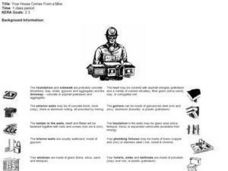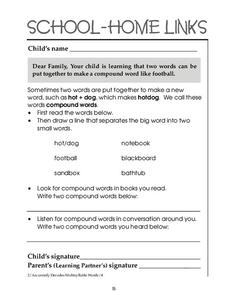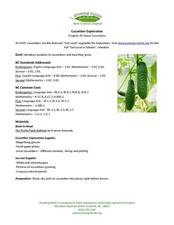Curated OER
Displacement and Density
High schoolers explore displacement. In this displacement and density lesson, pupils find the volume of irregular shaped objects. Afterward, they determine the volume of containers. They compute the amount of water displacement.
Curated OER
Sink or Float?
Have your class explore density and buoyancy using this resource. Learners read the book Who Sank the Boat, and use several items, such as rubber balls, bottle caps, wood, and other household items to conduct an experiment. Using a tub...
K12 Reader
The Jungle Book
Young readers complete a graphic organizer identifying the main idea and the supporting ideas in a passage taken from Rudyard Kipling's The Jungle Book.
How Does She
I'm a Summer Reading Star!
Reading is rewarding on its own, but why not add in some extra incentives? As individuals read, they can fill out the bingo board included here, earn coupons, create bookmarks, and fill out a banner, piece by piece.
Houghton Mifflin Harcourt
Celebrating Traditions: Extra Support Lessons (Theme 2)
Third graders needing extra support will benefit from the materials contained in this 42-page packet designed to be used with the Houghton Mifflin Harcourt textbook thematic unit celebrating traditions.
Virginia Department of Education
Soap, Slime, and Creative Chromatography
Do you think chromatography paper suffers from separation anxiety? Young chemists make soap, slime, silly putty, and experiment with chromatography in this instructional activity. The material includes clear instructions for each...
Concord Consortium
Graphing Elements
How do you graph a sentence? Scholars do just that as they represent relationships between independent and dependent variables with a graphical representation. Given a sentence, they determine the pertinent relationship and create a...
Poetry4kids
How to Write Funny Poetry — Chapter 3: Choosing a Topic
Nothing's better than a really funny poem! Help young writers craft their funny poems with a lesson on one of the most challenging parts of writing: picking what to write about.
American Museum of Natural History
What Do You Know About Virtual Water?
Did you know you can conserve water by drinking tea instead of coffee? Learn about other products that use larger amounts of virtual water in an online lesson. Pupils complete a series of questions to test their understanding of the...
Curated OER
Student Exploration: Building Topographic Maps
In this earthquake exploration worksheet, students complete 2 prior knowledge questions, then use "Building Topographic Maps Gizmo" to conduct several activities, completing short answer questions when finished.
Curated OER
Game Board Review
Students review previously taught material by playing a teacher made board game. They answer questions and move their pieces along the path to the end.
Curated OER
Your House Comes from a Mine
What do your learners know about mining? Invite them to read about all of the materials that come from mining that go into building a house. Additionally, they answer four questions at the bottom of the worksheet.
Curated OER
Hazardous Household Products Quiz
For this hazardous products quiz, students give short answers to fifteen questions related to hazardous material found in or around the home. Students are questioned about what to do in given situations.
Curated OER
Determination of Water Hardness
Students investigate water hardness. In this water hardness lesson plan, students determine the water hardness in 4 samples of water after buffering each. By using titration and an indicator, students can determine the amount of calcium...
Curated OER
School-Home Links: Compound Words
What is a compound word? Have young learners review compound words, identify the two independent words in a compound word, and look for examples through reading and listening. Send this home for independent practice, and make sure to...
Curated OER
Solving Math Problems In the Real World
Upper elementary and middles schoolers discuss and solve real world applications of math. They use formulas for volume and percents to answer real world questions. In the second part of the activity, groups write and solve word problems....
Curated OER
Addition Table
In this addition table instructional activity, 2nd graders complete the addition table and fill in the answer for numbers 1 through 10. Students complete 100 problems.
Growing Minds
Growing Minds: Cucumber Exploration
After reading a picture book about planting and harvesting cucumbers, learners get a chance to examine some cucumbers of their own. First, they see photographs of a cucumber on a vine, and learn that it is part of the gourd family. They...
San Francisco Public Utilities Commission
Recycled Water: A Smart Way to Reuse Water
Learn about wastewater and recycled water with a science reading activity. After learners finish a two-page passage about conserving the water supply, they answer six comprehension questions about what they have read.
Curated OER
Lesson 10-6: Using the Quadratic Formula
In this quadratic formula worksheet, students solve 5 quadratic problems. Students use the quadratic formula to find maximums, minimums, roots, and y-intercepts.
Curated OER
Quadratics with Irrational Solutions
In this algebra worksheet, students apply the concepts of a right triangle to help them solve for the missing sides of a triangle. They use the quadratic formula to solve word problems. There are 5 problems with an answer key.
Curated OER
Where Does it Come From?...Where Does it Go?
Students summarize and illustrate how a water treatment plant and wastewater treatment plant work. Students describe the source of water for their community and the adequacy of groundwater to meet the community's needs. Students also...
Curated OER
Mother's Day Story Time Activities
Young scholars examine all of the jobs a mother does. In this Mother's Day lesson, the teacher read the book Five Minutes' Peace, then students brainstorm a list of things their mother does. Young scholars role play the job of a mom...
Curated OER
Dragon Boats
Students create a model boat. In this art lesson, students identify what makes a boat float and use milk cartons to create their own boat.

























